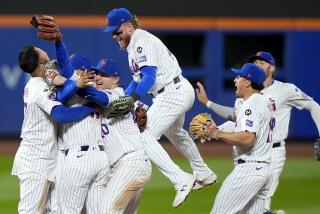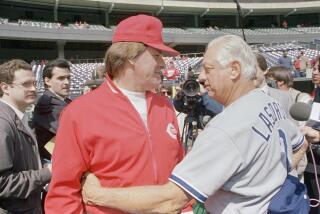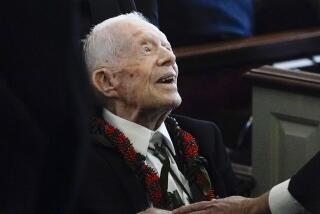Carter Stepped Away Before the Slow Fade : After a Few âSignsâ He Realized, âIt Was Definitely Time to Leaveâ
Gary Carter could have hung on for another season, extended his National League games-caught record, added a few more hits, homers and runs batted in to make his portfolio a little more attractive to Hall of Fame voters.
And as August was about to turn to September in 1992, Carter, who had returned to the Montreal Expos for his 18th major league season, had thoughts of a 19th tour of duty.
Then his wife, Sandy, was broadsided by a driver who ran a stop sign near their home in Palm Beach, Fla. Sandy escaped serious injury, but the familyâs car was nearly totaled.
A few days after the accident, Hurricane Andrew swept through Florida, threatening but not severely damaging Carterâs home.
Carter was shaken.
So were his priorities.
âHere I am in Montreal thinking, âGosh, what am I doing up here?â â Carter said. âI had thought about retiring, but at that point, I felt God had given me enough signs. It was definitely time to leave.â
Soon after this divine intervention, Carter said 1992 would be his last season. In his last at-bat, Carter doubled in the gameâs only run in a 1-0 victory over the Chicago Cubs in the Exposâ home finale. Montreal retired Carterâs No. 8.
âThey say youâre only as good as your last at-bat, and mine was a game-winning double,â said Carter, the former Sunny Hills High School three-sport standout who will be inducted into the Orange County Sports Hall of Fame on Sunday.
âBut both my knees were shot and it was tough to perform at the level I was used to. I figured rather than go through a mediocre year, Iâd go out on a high note. It was a wonderful run while it lasted. . . . I feel I achieved what I hope is good enough to land me in Cooperstown.â
Carterâs accomplishments will, at the least, warrant Cooperstown consideration. He had a career batting average of .262 with 2,092 hits, 324 home runs, 1,125 RBIs and 1,025 runs. Heâs third on the career games-caught list with 2,056, behind Carlton Fisk and Bob Boone.
He was named most valuable player in the 1981 and 1984 All-Star games and played in nine others. He caught every inning of the 1986 World Series and helped the New York Mets defeat the Boston Red Sox in a memorable seven-game affair.
Carter is one of four catchers in major league history with 2,000 hits, 300 homers, 1,000 RBIs and 1,000 runs. The others are Hall of Famers Yogi Berra and Johnny Bench, and Fisk, who is considered a lock for the Hall of Fame.
But they donât choose Hall of Famers by position. Carter may have been one of the premier catchers of his time, but his Cooperstown prospects, like those of so many players with outstanding statistics, will depend on the competition on the Hall of Fame ballot.
âIt would be a great honor, but Iâm not going to lose any sleep over it,â said Carter, 39, who is a color commentator on Florida Marlin telecasts. âI paid my dues, accomplished a lot--hopefully, itâs enough to get me there.â
If not, Carter can at least be proud of being inducted into two other sports halls of fame, Palm Beach and now Orange County. Carter grew up playing numerous youth sports in West Fullerton, and by the time he was a junior at Sunny Hills, he was captain of the football, basketball and baseball teams.
Carter signed a letter of intent to UCLA, and the quarterback had every intention of pursuing a college football career until a knee injury in his senior year steered him toward baseball.
A third-round pick of the Expos in 1972, Carter signed after graduating from high school and played three minor-league seasons before being called up to the majors in September, 1974.
His 10-year Montreal career (1975-84) included many individual highlights--his best season was 1984, when he batted .294 with 27 homers and a league-leading 106 RBIs.
But with the exception of strike-shortened 1981, when Montreal beat Philadelphia in the National League East Division playoff series and lost to the Dodgers in the National League Championship Series, the Expos were not regular pennant-race participants.
While Carter was a hero north of the border--one of former Canadian Prime Minister Pierre Trudeauâs favorite luncheon one-liners was: âIâm certainly happy that I donât have to run for reelection against Gary Carter.â--his exploits often were unnoticed in the United States.
That all changed after the 1984 season, when Carter was traded to the New York Mets.
The Mets just missed overtaking the St. Louis Cardinals in the NL East in Carterâs first season in New York, but the Mets won the division, the pennant and the World Series in Carterâs second year, 1986, and won another division title in 1988.
âThe trade to New York really enhanced my career,â Carter said. âMontreal had four beat writers, three who spoke French and one English. In New York, the coverage was like 10-fold. When youâre a successful team in that kind of media capital, you get a lot of good press.â
Some thought Carter went too far out of his way for good press. This was a guy who always seemed to play with a smile, who never cursed and rarely showed anger, who went by the nickname, âKid.â
He had a Steve Garvey-like, Mr. Clean image, but some teammates thought he hogged the spotlight a little too much.
âIt was jealousy more than anything else,â Carter said. âThey felt this guy was too good to be true, but I was the same as a rookie as I was the last day I took my uniform off.â
Carter was universally loved by the fans, though, and for good reason. He never seemed to tire of signing autographs, he returned every letter with an autographed picture, and he regularly mingled with fans before games.
He was the Congenial Catcher.
âIn my early days as a Little Leaguer, I admired big leaguers so much,â Carter said. âI knew the impact they had on younger kids and realized how much autographs meant to them. We donât have a lot of role models today, but I felt (accommodating the fans and reporters) was part of the responsibility of being a big-league player.â
The rewards of being a big-league player came to Carter in 1986. Carter was a key player on the Metsâ world championship team, batting .255 with 24 homers and 105 RBIs and finishing third behind Mike Schmidt and Glenn Davis in the National League MVP voting.
He struggled in the NLCS against the Houston Astros, going 1 for 21 before his game-winning, 12th-inning single off Charlie Kerfield in Game 5 gave the Mets a 3-2 advantage. Carter then had two hits in New Yorkâs pennant-clinching, 16-inning, 7-6 thriller in Game 6.
Carter had nine RBIs in the World Series--the second highest total ever by a catcher--and hit two home runs in Game 3 at Fenway Park to lead the Mets, who had lost the first two games in Shea Stadium, to victory.
But his finest World Series moment came in Game 6, with the Mets trailing, 5-3, in the bottom of the 10th inning and the Red Sox one out away from a world championship.
Carter started a rally with a two-out single, moved to second on Kevin Mitchellâs single and scored on Ray Knightâs single.
Mitchell scored the tying run on Bob Stanleyâs wild pitch, and Knight scored the winning run when Mookie Wilsonâs chopper went through Boston first baseman Bill Bucknerâs legs and into World Series history.
The Mets won Game 7 the following night for their first World Series championship since 1969.
âIâve had a lot of proud moments--a seven-RBI game against the Braves (in 1986), a five-for-five game against Greg Maddux and the Cubs (in 1990), two All-Star MVP awards,â Carter said. âBut, shoot, nothing tops a World Series title.â
Gary Carter in the Major Leagues
Year Team Avg. G AB R H 2B 3B HR RBI 1974 Montreal .407 9 27 5 11 0 1 1 6 1975 Montreal .270 144 503 58 136 20 1 17 68 1976 Montreal .219 91 311 31 68 8 1 6 38 1977 Montreal .284 154 522 86 148 29 2 31 34 1978 Montreal .255 157 533 76 136 27 1 20 72 1979 Montreal .283 141 505 74 143 26 5 22 75 1980 Montreal .264 154 549 76 145 25 5 29 101 1981 Montreal .251 100 374 48 94 20 2 16 68 1982 Montreal .293 154 557 91 163 32 1 29 97 1983 Montreal .270 145 541 63 146 37 3 17 79 1984 N.Y. Mets .294 159 596 75 175 32 1 27 106 1985 N.Y. Mets .281 149 555 83 156 17 1 32 100 1986 N.Y. Mets .255 132 490 81 125 14 2 24 105 1987 N.Y. Mets .235 139 523 55 123 18 2 20 83 1988 N.Y. Mets .242 130 455 39 110 16 2 11 46 1989 N.Y. Mets .183 50 153 14 28 8 0 2 15 1990 San Francisco .254 92 244 24 62 10 0 9 27 1991 Dodgers .246 101 248 22 61 14 0 6 26 1992 Montreal .218 95 285 24 62 18 1 5 29
Hall of Fame Induction Facts
What: 13th Orange County Hall of Fame induction ceremony
Where: Gate 6, Anaheim Stadium
When: 11 a.m., Sunday
Highlights: Ceremony inducting Bert Blyleven, Gary Carter, Maurice (Red) Guyer, Hal Sherbeck, Jerry Shipkey and Ray Willsey will take place outside Anaheim Stadium. The public can then gain admission to the newly opened Hall of Fame for $3.
More to Read
Go beyond the scoreboard
Get the latest on L.A.'s teams in the daily Sports Report newsletter.
You may occasionally receive promotional content from the Los Angeles Times.











